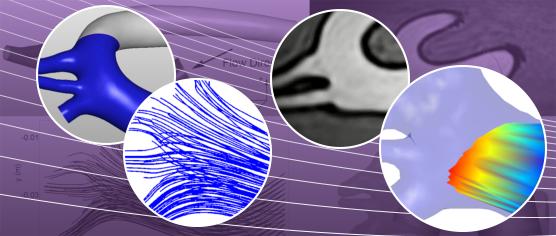Gülan, U., Lüthi, B., Holzner, M., Liberzon, A., Tsinober, A., Kinzelbach W.

The compliance of the aorta, which is a function of the wall properties, e.g. material, thickness and geometry, is a hallmark of cardiovascular flows. Expansion and contraction of the aortic wall is believed to considerably influence the flow features. The compliance characteristics are associated with aging which is one of the primary causes of arterial stiffening. A three-dimensional pulsatile aortic flow in a human ascending aorta is studied to investigate the effect of the aortic stiffness on the flow field and turbulent fluctuating velocities in the ascending aorta. A non-intrusive optical measurement technique, 3D Particle Tracking Velocimetry (3D-PTV), has been applied to anatomically accurate phantoms under clinically realistic conditions. A compliant silicon phantom was used to mimic the healthy aorta and a rigid model was used to imitate the pathological case that appears in aortas for example as a result of aging. Our results revealed that the aortic stiffness leads to an increase in systolic velocity and a decrease in the Windkessel effect, which is associated with the diastolic blood pressure. Furthermore, we found that the turbulent kinetic energy is about an order of magnitude higher for the rigid aorta, that is, an increase in aortic stiffness increases the magnitude of turbulent fluctuating velocities. The spatial distribution of the flow velocity showed that the flow is more organized and coherent spiraling patterns develop for the compliant aorta which helps to dampen the influence of disturbed flow. Finally, we observed higher Lagrangian acceleration and hence higher instantaneous forces acting on blood particles in the stiff case which implies that aging and hence arterial stiffening provokes distinctive alterations in blood flow and these alterations may cause pathological symptoms in the cardiovascular system.
